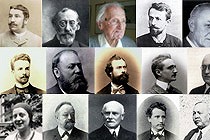
|
Encyclopaedia of Architects, Vienna 1770 - 1945 With the 'Architektenlexikon Wien 1770 - 1945', for the first time there is a comprehensive reference work available on the architects, master builders, town planners and theoreticians whose impact on the urban fabric of Vienna can still be seen today. The criteria taken into consideration relate to biographical details, architecture aesthetics, architecture history, urban development and style, providing a holistic insight into the material concerned that extends well beyond the scope of standard reference works in the field. Architektenlexikon Wien 1770 - 1945 The lexicon does not only pay tribute to 'great' personalities among the Vienna architects, such as Theophil Hansen, Heinrich Ferstel, Friedrich Schmidt, Otto Wagner, Adolf Loos, Camillo Sitte or Clemens Holzmeister, to name but a few, but also includes all those whose biographies and works have remained largely unknown or inaccessible. Included are those Austrian or international planners who were able to complete either several projects in Vienna, or at least one public monumental building, as well as those architects who were primarily involved in teaching or productive as theorists. The aim of the project is to update existing lexica (e.g. 'Lexikon der Bildenden Künste' by Thieme-Becker), to correct incorrect details and, in particular, to publicise those architects who have previously been overlooked. In 2008 the details were published of around 700 architects who were active in Vienna in the period between 1880 and 1945. This information is currently being supplemented with details of the architects' biographies between 1770 and 1880, and available in an ongoing process for users from the sciences and undertaking research, building conservationists and urban planners, but also to students and interested members of the public. With the completion of this supplementary project in September 2013, the encyclopedia now contains entries for around 1050 architects. The numerous enquiries and responses from national and international researchers of different fields show that a serious gap in architectural research has been closed with the 'Wiener Architektenlexikon 1770–1945', and that a series of new research work has been inspired by the information published for the first time in the lexicon. Processing period: 2003 – 2013 Supported by the Austrian Science Fund (FWF): P16395-G06, P19700-G08 and P21447-G21 |
 |
|
© Az W |
|
Encyclopaedia of Architects - Structure - Online Service - Project Team - Research Results - List of Architects - Acknowledgments Educational Facilities Index of Archives Literature Downloads: List of Architects Links: Encyclopaedia of Architects, Vienna 1770 - 1945 Information: Sonja Pisarik Tel.: +43 (1) 522 31 15 - 26 Fax: +43 (1) 522 31 17 Email: pisarik@azw.at Katrin Stingl Tel.: +43 (1) 522 31 15-37 Fax: +43 (1) 522 31 17 Email: stingl@azw.at Monika Platzer Tel.: +43 (1) 522 31 15 - 21 Fax: +43 (1) 522 31 17 Email: platzer@azw.at |
| © Architekturzentrum Wien 2025 |
||



